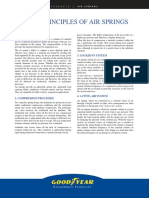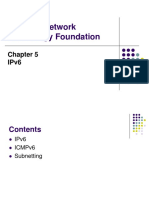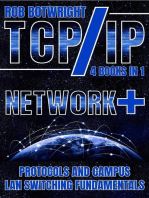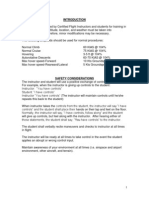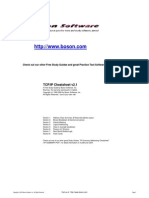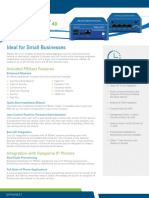Ipv6 Reference Card
Ipv6 Reference Card
Uploaded by
D ARUL KUMARESANCopyright:
Available Formats
Ipv6 Reference Card
Ipv6 Reference Card
Uploaded by
D ARUL KUMARESANCopyright
Available Formats
Share this document
Did you find this document useful?
Is this content inappropriate?
Copyright:
Available Formats
Ipv6 Reference Card
Ipv6 Reference Card
Uploaded by
D ARUL KUMARESANCopyright:
Available Formats
IPv6 Address Types
Prex ::/128 Designation and Explanation Unspecied This address may only be used as a source address by an initialising host before it has learned its own address. Loopback This address is used when a host talks to itself over IPv6. This often happens when one program sends data to another. IPv4-Mapped These addresses are used to embed IPv4 addresses in an IPv6 address. One use for this is in a dual stack transition scenario where IPv4 addresses can be mapped into an IPv6 address. See RFC 4038 for more details. Unique Local Addresses (ULAs) These addresses are reserved for local use in home and enterprise environments and are not public address space. These addresses might not be unique, and there is no formal address registration. Packets with these addresses in the source or destination elds are not intended to be routed on the public Internet but are intended to be routed within the enterprise or organisation. See RFC 4193 for more details. fe80::/10 Example: fe80::200:5aee:feaa:20a2 Link-Local Addresses These addresses are used on a single link or a non-routed common access network, such as an Ethernet LAN. They do not need to be unique outside of that link. Link-local addresses may appear as the source or destination of an IPv6 packet. Routers must not forward IPv6 packets if the source or destination contains a linklocal address. Link-local addresses may appear as the source or destination of an IPv6 packet. Routers must not forward IPv6 packets if the source or destination contains a linklocal address. 169.254.0.0/16 0.0.0.0 IPv4 Equivalent
::1/128
127.0.0.1
::ffff/96 Example: ::ffff:192.0.2.47
There is no equivalent. However, the mapped IPv4 address can be looked up in the relevant RIRs Whois database.
fc00::/7 Example: fdf8:f53b:82e4::53
Private, or RFC 1918 address space: 10.0.0.0/8 172.16.0.0/12 192.168.0.0/16
This sheet is available at www.ripe.net/ipv6-address-types Produced by the RIPE NCC in cooperation with ICANN www.ripe.net www.icann.org
IPv6 Address Types
Prex
2001:0000::/32 Example: 2001:0000:4136:e378: 8000:63bf:3fff:fdd2
Designation and Explanation
Teredo This is a mapped address allowing IPv6 tunneling through IPv4 NATs. The address is formed using the Teredo prex, the servers unique IPv4 address, ags describing the type of NAT, the obfuscated client port and the client IPv4 address, which is probably a private address. It is possible to reverse the process and identify the IPv4 address of the relay server, which can then be looked up in the relevant RIRs Whois database. You can do this on the following webpage: http://www.potaroo.net/cgi-bin/ipv6addr
IPv4 Equivalent
No equivalent
2001:0002::/48 Example: 2001:0002:6c::430 2001:0010::/28 Example: 2001:10:240:ab::a
Benchmarking These addresses are reserved for use in documentation. They should not be used as source or destination addresses. Orchid These addresses are used for a xed-term experiment. They should only be visible on an end-to-end basis and routers should not see packets using them as source or destination addresses. 6to4 A 6to4 gateway adds its IPv4 address to this 2002::/16, creating a unique /48 prex. As the IPv4 address of the gateway router is used to compose the IPv6 prex, it is possible to reverse the process and identify the IPv4 address, which can then be looked up in the relevant RIRs Whois database. You can do this on the following webpage: http://www.potaroo.net/cgi-bin/ipv6addr
198.18.0.0/15
No equivalent
2002::/16 Example: 2002:cb0a:3cdd:1::1
There is no equivalent but 192.88.99.0/24 has been reserved as the 6to4 relay anycast address prex by the IETF.
2001:db8::/32 Example: 2001:db8:8:4::2 2000::/3
Documentation These addresses are used in examples and documentation. They should never be source or destination addresses. Global Unicast Other than the exceptions documented in this table, the operators of networks using these addresses can be found using the Whois servers of the RIRs listed in the registry at: http://www.iana.org/assignments/ipv6unicast-address-assignments Multicast These addresses are used to identify multicast groups. They should only be used as destination addresses, never as source addresses.
192.0.2.0/24 198.51.100.0/24 203.0.113.0/24 No equivalent single block
ff00::/8 Example: ff01:0:0:0:0:0:0:2
224.0.0.0/4
This sheet is available at www.ripe.net/ipv6-address-types Produced by the RIPE NCC in cooperation with ICANN www.ripe.net www.icann.org
You might also like
- IP Routing Protocols All-in-one: OSPF EIGRP IS-IS BGP Hands-on LabsFrom EverandIP Routing Protocols All-in-one: OSPF EIGRP IS-IS BGP Hands-on LabsNo ratings yet
- VXLANDocument2 pagesVXLANkamarajk22No ratings yet
- IPv6 FundamentalsDocument44 pagesIPv6 FundamentalsIvan Finek100% (1)
- CCNA Cheat Sheet IPv6Document4 pagesCCNA Cheat Sheet IPv6Thomas SchmelingNo ratings yet
- Enterprise Could Obtain An Administrative Assignment of A Block of Ipv6 Global Unicast IpDocument9 pagesEnterprise Could Obtain An Administrative Assignment of A Block of Ipv6 Global Unicast IpKundan PrasadNo ratings yet
- Goodyear Air Spring Data PDFDocument157 pagesGoodyear Air Spring Data PDFD ARUL KUMARESANNo ratings yet
- Natural Frequencies - Human BeingDocument4 pagesNatural Frequencies - Human BeingD ARUL KUMARESAN100% (2)
- HuaweiDocument66 pagesHuaweiLyric Dubey100% (1)
- M120TDocument24 pagesM120TIsmail SosseyNo ratings yet
- Ipv6 Reference Card PDFDocument2 pagesIpv6 Reference Card PDFJosé Antonio Muñoz JiménezNo ratings yet
- Prefix Designation and Explanation Ipv4 Equivalent UnspecifiedDocument2 pagesPrefix Designation and Explanation Ipv4 Equivalent Unspecifiedkundan1094No ratings yet
- Prefix Designation and Explanation Ipv4 Equivalent UnspecifiedDocument2 pagesPrefix Designation and Explanation Ipv4 Equivalent UnspecifiedlunganaNo ratings yet
- Ipv6 Reference CardDocument2 pagesIpv6 Reference Cardhim2000himNo ratings yet
- Tipi Di Indirizzi IPv6Document2 pagesTipi Di Indirizzi IPv6Luca SpontaNo ratings yet
- Difference Between IPv4 and IPv6Document5 pagesDifference Between IPv4 and IPv6Ardit Mezini100% (1)
- Mikrotik - IPv6Document45 pagesMikrotik - IPv6Musyaffak SNo ratings yet
- Implementing Ipv6 Addressing and Basic Connectivity: - Ipv6, Formerly Named Ipng (Next Generation)Document71 pagesImplementing Ipv6 Addressing and Basic Connectivity: - Ipv6, Formerly Named Ipng (Next Generation)Paresh V PatelNo ratings yet
- Lecture 3Document25 pagesLecture 3Hạnh Hoàng ĐìnhNo ratings yet
- Networking Ipv6 User Guide For J2Sdk/Jre 1.4Document6 pagesNetworking Ipv6 User Guide For J2Sdk/Jre 1.4harry_rockNo ratings yet
- CN Notes 4Document18 pagesCN Notes 4lard BaringNo ratings yet
- Chapter 10 IP Version 6Document60 pagesChapter 10 IP Version 6nuhonoNo ratings yet
- WIA1005 Network Technology FoundationDocument35 pagesWIA1005 Network Technology FoundationAina NajihahNo ratings yet
- IPv6 PrefixDocument1 pageIPv6 PrefixAnisabella BadriNo ratings yet
- Lesson 3: IPv6 FundamentalsDocument35 pagesLesson 3: IPv6 FundamentalsMahmmoud MahdiNo ratings yet
- Ip V 6: - Ipng Short For Internet Protocol Next Generation, A New Version of The Internet Protocol (Ip)Document7 pagesIp V 6: - Ipng Short For Internet Protocol Next Generation, A New Version of The Internet Protocol (Ip)karthikaNo ratings yet
- Comparison Between Internet Protocol Version 4 and 6Document9 pagesComparison Between Internet Protocol Version 4 and 6كمال الطويرNo ratings yet
- TransitionDocument41 pagesTransitionMuhtar IzuNo ratings yet
- Chapter1 - Understanding and Configuring TCP-IP PDFDocument9 pagesChapter1 - Understanding and Configuring TCP-IP PDFJh0n Fredy HNo ratings yet
- What Is The Difference Between IPv4 and IPv6 AddressingDocument12 pagesWhat Is The Difference Between IPv4 and IPv6 AddressingJonathan JaegerNo ratings yet
- 19 IPv6 BasicsDocument35 pages19 IPv6 BasicsAsma ElmangoushNo ratings yet
- Ipv6 Address Types Address Type DescriptionDocument5 pagesIpv6 Address Types Address Type DescriptionroutemansNo ratings yet
- Ipv6 Cheat SheetDocument2 pagesIpv6 Cheat SheetnightphreakNo ratings yet
- Chapter 4b IPv6 FeaturesDocument18 pagesChapter 4b IPv6 Featuresbettelly84No ratings yet
- Ipv6 Cheat SheetDocument2 pagesIpv6 Cheat Sheetdecheverri100% (1)
- Lla in Ipv6 (Internet Protocol Version 6) : Every Interface in Ipv6 Must Have A LinkDocument2 pagesLla in Ipv6 (Internet Protocol Version 6) : Every Interface in Ipv6 Must Have A LinkBeryl NishaNo ratings yet
- Ipv6 Cheat SheetDocument2 pagesIpv6 Cheat SheetKarlNo ratings yet
- Ipv6 Tutorial: Go To CommentsDocument6 pagesIpv6 Tutorial: Go To CommentsDinkar SharmaNo ratings yet
- IPv6 SlideDocument35 pagesIPv6 SlideChantich CharmtongNo ratings yet
- Ipv4 Vs Ipv6Document1 pageIpv4 Vs Ipv6Pratik GandhiNo ratings yet
- Name of Course: E1-E2 CFADocument20 pagesName of Course: E1-E2 CFArebba89No ratings yet
- IPv6 PDFDocument61 pagesIPv6 PDFNay OoNo ratings yet
- IPv 6Document21 pagesIPv 6hagala4120No ratings yet
- IPv6 AddressingDocument61 pagesIPv6 AddressingmridulNo ratings yet
- Multicast Address: From Wikipedia, The Free EncyclopediaDocument5 pagesMulticast Address: From Wikipedia, The Free EncyclopediaNishant MishraNo ratings yet
- Ipv6 Tutorial: Address Type DescriptionDocument5 pagesIpv6 Tutorial: Address Type DescriptionSani MuhlisonNo ratings yet
- CNE Tutorial 10 - IPv6 Configuration and Static RoutingDocument18 pagesCNE Tutorial 10 - IPv6 Configuration and Static RoutingLiên VũNo ratings yet
- Ipv6 Cheat SheetDocument2 pagesIpv6 Cheat SheetVinoth RNo ratings yet
- ACN Notes Ch2Document14 pagesACN Notes Ch2None Of Ur BusinessNo ratings yet
- AutoconfigurationDocument9 pagesAutoconfigurationvadapav2901No ratings yet
- E1-E2 - Text - Chapter 4. IPV6Document16 pagesE1-E2 - Text - Chapter 4. IPV6abhimirachi7077No ratings yet
- 12 Advanced TCPIP ConfigurationDocument10 pages12 Advanced TCPIP ConfigurationChis LebroNo ratings yet
- Unit - V: Application DevelopmentDocument42 pagesUnit - V: Application DevelopmentKarthi KeyanNo ratings yet
- IPv 6Document29 pagesIPv 6meriem hasNo ratings yet
- Ipv6 Integration: Building The InfrastructureDocument9 pagesIpv6 Integration: Building The InfrastructureImamahNo ratings yet
- 7.2.5.3 Lab - Identifying IPv6 AddressesDocument7 pages7.2.5.3 Lab - Identifying IPv6 Addressesرافد البركي100% (7)
- Chapter 6: Rarp: AddressDocument4 pagesChapter 6: Rarp: AddressTarun S VatsNo ratings yet
- ICND2-Chapter17 Key IdeasDocument5 pagesICND2-Chapter17 Key Ideashoang nguyen baNo ratings yet
- Shortened ExpressionDocument6 pagesShortened ExpressionDebashish RoyNo ratings yet
- Three Changes To IPv6Document8 pagesThree Changes To IPv6glen_turnerNo ratings yet
- Acn M.P ReportDocument8 pagesAcn M.P ReportDuty100% (1)
- ACN Chapter 2 - Part 2 Notes by Ur Engineering FriendDocument11 pagesACN Chapter 2 - Part 2 Notes by Ur Engineering Friendpapratiksha377No ratings yet
- Wireshark for Security Professionals: Using Wireshark and the Metasploit FrameworkFrom EverandWireshark for Security Professionals: Using Wireshark and the Metasploit FrameworkRating: 4 out of 5 stars4/5 (1)
- TCP/IP: Network+ Protocols And Campus LAN Switching FundamentalsFrom EverandTCP/IP: Network+ Protocols And Campus LAN Switching FundamentalsNo ratings yet
- Practical Internet Server Configuration: Learn to Build a Fully Functional and Well-Secured Enterprise Class Internet ServerFrom EverandPractical Internet Server Configuration: Learn to Build a Fully Functional and Well-Secured Enterprise Class Internet ServerNo ratings yet
- Ads 27a SPDocument31 pagesAds 27a SPD ARUL KUMARESANNo ratings yet
- 2013 SOLIDWORKS Help - Modal DampingDocument3 pages2013 SOLIDWORKS Help - Modal DampingD ARUL KUMARESANNo ratings yet
- Dynamic Equivalent Load - Basic Bearing Knowledge - Koyo Bearings - JTEKT CORPORATIONDocument13 pagesDynamic Equivalent Load - Basic Bearing Knowledge - Koyo Bearings - JTEKT CORPORATIOND ARUL KUMARESANNo ratings yet
- Short Beam Strength - D2344.1176581-1Document8 pagesShort Beam Strength - D2344.1176581-1D ARUL KUMARESANNo ratings yet
- Brown RE - Strathprints - Main Rotor-Tail Rotor Interaction and Its Implications For Helicopter Directional Control Apr 08 PDFDocument14 pagesBrown RE - Strathprints - Main Rotor-Tail Rotor Interaction and Its Implications For Helicopter Directional Control Apr 08 PDFD ARUL KUMARESANNo ratings yet
- Fatigue Blade Imp PDFDocument6 pagesFatigue Blade Imp PDFaruatscribdNo ratings yet
- MIL B 81820fDocument25 pagesMIL B 81820fD ARUL KUMARESANNo ratings yet
- 146 Reasons Why Sugar Is Ruining Your HealthDocument5 pages146 Reasons Why Sugar Is Ruining Your HealthD ARUL KUMARESANNo ratings yet
- Airworthiness Standards FAA FAR Part 27Document84 pagesAirworthiness Standards FAA FAR Part 27D ARUL KUMARESANNo ratings yet
- Brown RE - Strathprints - Main Rotor-Tail Rotor Interaction and Its Implications For Helicopter Directional Control Apr 08 PDFDocument14 pagesBrown RE - Strathprints - Main Rotor-Tail Rotor Interaction and Its Implications For Helicopter Directional Control Apr 08 PDFD ARUL KUMARESANNo ratings yet
- Reliability Software, Weibull Distribution, Test Design, Failure AnalysisDocument6 pagesReliability Software, Weibull Distribution, Test Design, Failure AnalysisD ARUL KUMARESANNo ratings yet
- 10FTM05 KirovDocument9 pages10FTM05 KirovD ARUL KUMARESANNo ratings yet
- Abbreviated R22 Maneuvers GuideDocument29 pagesAbbreviated R22 Maneuvers GuideLavern P. SipinNo ratings yet
- Life Extension Methods in Aero-Engines OMMI (Vol.3, Issue 1) April 2004Document15 pagesLife Extension Methods in Aero-Engines OMMI (Vol.3, Issue 1) April 2004D ARUL KUMARESANNo ratings yet
- List of International Organization For Standardization StandardsDocument24 pagesList of International Organization For Standardization StandardsD ARUL KUMARESANNo ratings yet
- Turning FlightDocument12 pagesTurning FlightD ARUL KUMARESANNo ratings yet
- Analysis Method For Inertial Particle SeparatorDocument9 pagesAnalysis Method For Inertial Particle SeparatorD ARUL KUMARESANNo ratings yet
- Turn Performance Sustained Level Turns: by David F. RogersDocument4 pagesTurn Performance Sustained Level Turns: by David F. RogersD ARUL KUMARESANNo ratings yet
- Address Change FormDocument1 pageAddress Change FormD ARUL KUMARESAN0% (1)
- Water, Density, Specific Enthalpy, ViscosityDocument3 pagesWater, Density, Specific Enthalpy, ViscosityD ARUL KUMARESANNo ratings yet
- Flow Angle Probe Miniature Is Pressure TransducerDocument2 pagesFlow Angle Probe Miniature Is Pressure TransducerD ARUL KUMARESANNo ratings yet
- Airpcap User GuideDocument26 pagesAirpcap User Guidegermany29No ratings yet
- Sonicwall TZ Series Datasheet 68221Document13 pagesSonicwall TZ Series Datasheet 68221ramanj123No ratings yet
- Rectangular Dielectric Resonator Antenna Array For 28 GHZ ApplicationsDocument9 pagesRectangular Dielectric Resonator Antenna Array For 28 GHZ ApplicationsSaif KamalNo ratings yet
- Stephen - Trainee-Progress-SheetDocument1 pageStephen - Trainee-Progress-SheetStephenson JacobNo ratings yet
- 20C507B Introduction To VXLANDocument59 pages20C507B Introduction To VXLANGordon Mac DonaldNo ratings yet
- Tia 492aaae 2016Document42 pagesTia 492aaae 2016redabeneyadNo ratings yet
- Token BucketDocument15 pagesToken BucketAditya DandotiaNo ratings yet
- OFDM PresentationDocument15 pagesOFDM PresentationSama BlessyamulyaNo ratings yet
- GS_EP_TEL_410_ENDocument26 pagesGS_EP_TEL_410_ENFOTOS SURENDNo ratings yet
- Final Year Project IdeasDocument44 pagesFinal Year Project IdeasMuhammad AshrafNo ratings yet
- Tut06 AnswersDocument3 pagesTut06 AnswersAbub114No ratings yet
- TCP/IP Cheatsheet v2.1: Check Out Our Other Free Study Guides and Great Practice Test Software!Document10 pagesTCP/IP Cheatsheet v2.1: Check Out Our Other Free Study Guides and Great Practice Test Software!Ernesto CaraballoNo ratings yet
- Whitepaper SocialNetworking Tyntec 20111201 Final PDFDocument4 pagesWhitepaper SocialNetworking Tyntec 20111201 Final PDFJessica HarveyNo ratings yet
- Mobile Banking On The Increase in Developing CountriesDocument2 pagesMobile Banking On The Increase in Developing CountriesRadi Sastra100% (1)
- Application Note #41A Update On The Latest Release of IEC 61000-4-3, Edition 3Document9 pagesApplication Note #41A Update On The Latest Release of IEC 61000-4-3, Edition 3LOUKILkarimNo ratings yet
- Hcia Lte GeralDocument48 pagesHcia Lte Geralvictor kudidissaNo ratings yet
- Emotion, Sens., Def, Spirit: CT044/07/R Update Instructions CTDocument18 pagesEmotion, Sens., Def, Spirit: CT044/07/R Update Instructions CTAmmar SaadNo ratings yet
- ITERA Lecture2Document12 pagesITERA Lecture2Kuys Jeremy LazoNo ratings yet
- Yxc API Spec BasicDocument61 pagesYxc API Spec Basicbla fa100% (1)
- Sangoma Pbxact 40 DatasheetDocument2 pagesSangoma Pbxact 40 DatasheetRicardo Gilmore GonzalezNo ratings yet
- Assignment in Econ 1Document4 pagesAssignment in Econ 1Zion TesalonaNo ratings yet
- Motorola HT 750 User ManualDocument37 pagesMotorola HT 750 User Manualomar hasqilNo ratings yet
- Link Budget of Gsm&Umts&CdmaDocument20 pagesLink Budget of Gsm&Umts&CdmaMehmet CetinNo ratings yet
- Integrating SNMP NbiDocument17 pagesIntegrating SNMP NbiJorge Alejandro MartinezNo ratings yet
- Line Code DecoderDocument11 pagesLine Code DecoderMor DepRzNo ratings yet
- Television Rating PointsDocument5 pagesTelevision Rating PointspayalsaloniNo ratings yet
- Office Automation Unit 5Document17 pagesOffice Automation Unit 5sagondachrispinNo ratings yet





